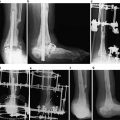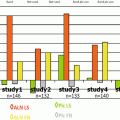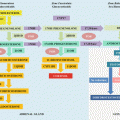Sensorimotor neuropathy
Distal symmetric polyneuropathy
Focal neuropathy
Diabetic mononeuropathy (cranial, truncal, peripheral nerves)
Mononeuropathy multiplex
Diabetic amyotrophy
Autonomic neuropathy
Hypoglycemic unawareness
Abnormal pupillary function
Cardiovascular autonomic neuropathy
Vasomotor neuropathy
Sudomotor neuropathy (sweat glands)
Gastrointestinal autonomic neuropathy
Gastric atony
Diabetic diarrhea or constipation
Fecal incontinence
Genitourinary autonomic neuropathy
Bladder dysfunction
Sexual dysfunction
The pathogenesis of the diabetic neuropathy is complex. The Implicated metabolic factors include the following: accumulation of advanced glycosylation end products, accumulation of sorbitol, disruption of the hexosamine pathway, disruption of the protein kinase C pathway, activation of the poly (ADP-ribose) polymerase pathway, increased oxidative stress. This occurs in a fiber-selective pattern that preferentially affects distal sensory and autonomic fibers, leading to the progressive loss of sensation that underlies the clinical manifestations of diabetic polyneuropathy [4].
Clinical diabetic neuropathy is categorized into distinct syndromes according to the neurologic distribution. There are many forms of diabetic neuropathy including symmetric polyneuropathy, autonomic neuropathy, radiculopathies, and focal and multifocal neuropathies. Clinical and subclinical neuropathy has been estimated to occur in 10–100 % of diabetic patients, depending upon the diagnosistic criteria and patient populations examined. Prevalence is a function of disease duration, about 50 % of patients with diabetes will develop neuropathy, and about 25 % of those patients will experience no pain at all [5]. Most common among the neuropathies are chronic sensorimotor distal symmetric polyneuropathy [1] The chronic sensorimotor distal polyneuropathy represents a diffuse symmetric and length-dependent injury to peripheral nerves that has major implications on quality of life, morbidity, and costs from a public health perspective [1, 6]. Diabetic neuropathy can affect any part of the nervous system. Painful diabetic neuropathy (PDN) affects 16 % of patients with diabetes, and it is frequently unreported (12.5 %) and more frequently untreated (39 %) [7].
Diabetic neuropathy should be suspect in all patients with type 2 diabetes and in patients who have had type 1 diabetes for more than 5 years [2]. In some instances, patients with diabetic neuropathy have few complaints, but their physical examination reveals mild to moderately severe sensory loss [1, 2]. Ten to 18 % of patients have evidence of nerve damage at the time their diabetes is diagnosed, suggesting that even early impairment of glucose handling, classified as prediabetes, may be associated with neuropathy.
The early recognition and appropriate management of neuropathy in the patient with diabetes is important for several reasons, nondiabetic neuropathies may be present in diabetic patients, a number of treatment options exist for symptomatic diabetic neuropathy, autonomic neuropathy may involve every system in the body, autonomic neuropathy cause substantial morbidity and increased mortality, particularly if cardiovascular autonomic neuropathy is present. Because >80 % of amputations follow a foot ulcer or injury, early recognition of at-risk patients, providing education and appropriate care may reduce ulceration and amputation [1, 8].
Peripheral Neuropathy
This is the most common presentation of neuropathy in the diabetic patient. Up to 50 % of patients may experience symptoms. Patients may not volunteer symptoms but on inquiry admit that feet feel numb or dead. Patients with prediabetes may present with intense painful feet. The diabetic polyneuropathy is frequently insidious in onset and can lead to formation of foot ulcers and muscle and joint disease.
When to Suspect
Diabetic neuropathy should be suspected in any patient with type 1 diabetes for more than 5 years in duration and in all patients with type 2 diabetes. Patients with prediabetes presenting with “idiopathic” painful neuropathy, diabetic neuropathy should be suspect [1, 2, 8].
The diabetic patients should be screened annually (Table 35.2) by examining pinprick, temperature and vibration perception (using a 128 Hz-tuning fork), 10 g monofilament pressure sensation at the distal halluces and ankle reflexes. Combinations of more than one test have 87 % sensitivity in detecting polyneuropathy. Loss of 10 g monofilament perception and reduced vibration perception predict foot ulcers [1, 8]. The feet should be examined for ulcers, calluses and deformities and footwear should be inspected.
Table 35.2
Symptoms of diabetic neuropathy
Sensorimotor neuropathy |
Muscular symptoms: muscle weakness (not fatigue), atrophy, balance problems, ataxic gait |
Sensory symptoms: pain, paresthesia, numbness, paralysis, cramping, night time falls, antalgic gait |
Autonomic neuropathy |
Cardiovascular symptoms: exercise intolerance, fatigue, sustained heart rate, syncope, dizziness, lightheadedness, balance problems |
Gastrointestinal symptoms: dysphagia, bloating, nausea and vomiting, diarrhea, constipation, loss of bowel control |
Genitourinary symptoms: loss of bladder control, urinary tract infection, urinary frequency or dribbling, erectile dysfunction, loss of libido, dyspareunia, vaginal dryness, anorgasmia |
Sudomotor (sweat glands) symptoms: pruritus, dry skin, limb hair loss, calluses, reddened areas |
Endocrine symptoms: hypoglycemic unawareness |
Other symptoms: difficulty driving at night, depression, anxiety, sleep disorders, cognitive changes |
The diagnosis of diabetic polyneuropathy is based on interpretation of a costellation of symptoms and signs such as loss of vibratory or light touch sensation and reduced or absent ankle tendon reflexes [1, 5]. The symptoms most frequently found are burning pain, electrical or stabbing sensations, parasthesiae or dysesthesias in the lower extremities. Accurate assessment of symptoms in diabetic neuropathy is known to be difficult. Symptoms do not always indicate underlying neuropathy, as absence of symptoms should never be assumed to indicate an absence of signs. Therefore we should rely on clinical signs to diagnose diabetic neuropathy. Confirmation can be made with and quantitative electrophysiology [5] (Table 35.3).
Table 35.3
Evaluation for diabetic neuropathy
History |
Screen for symptoms of diabetic neuropathy (see also Table 35.4) |
Review diabetes history, disease management, daily glycemic records, and previous hemoglobin A1C levels |
Identify any family history of diabetes or neuropathy |
Review medication history (including use of over-the-counter products and herbal or homeopathic products) and environmental exposures |
Review for other causes of neuropathy, including vitamin B12 deficiency, alcoholism, toxic exposures, medications, cancers, and autoimmune disease |
Physical examination |
Vital signs and pain index |
Supine and standing blood pressure for postural hypotension |
Cardiovascular examination to look for arrhythmias, absent or diminished pulses, edema, or delayed capillary refilling |
Cutaneous examination to look for extremity hair loss, skin or nail changes (including callus), and pretrophic (red) areas, especially between toes |
Neurologic examination using the 5.07 Semmes-Weinstein (10-g) nylon filament test (10-g monofilament test) |
Inspection of feet for asymmetry, loss of arch height, or hammer toes |
Evaluation of all positive screening findings |
Main Characteristics of Diabetic Polyneuropathy
The diabetic polyneuropathy can be defined as the presence of symptoms and/or signs of peripheral nerve dysfunction in people with diabetes after exclusion of other causes [9]. The neuropathy pain is typically worse at night and symptoms are most commonly experience in feet more than calves and lower limbs, although in some cases the hands may be affected. The physical examination may be helpful, usually reveals sensory loss of vibration, pain, temperature perception, and loss of deep tendon reflexes [9].
Screening Tests
The need to identify simplified criteria has resulted in the development of at least two simple screening test scores, one is the United Kingdom screening score (Table 35.4) [10] and the other is the Michigan screening score (Table 35.5) [11].
Table 35.4
United Kingdom screening score
Symptoms |
What is the sensation felt? Maximum is 2 points |
• Burning, numbness, or tingling in the feet (2 points); |
• Fatigue, cramping, or aching (1 point) |
What is the location of symptoms? Maximum is 2 points |
• Feet (2 points) |
• Calves (1 points) |
• Elsewhere (0 points) |
Have the symptoms ever awakened you at night? |
• Yes (1 point) |
What is the timing of symptoms? Maximum 2 points |
• Worse at night (2 points) |
• Present day and night (1 point) |
• Present only during the day (0 points) |
How are symptoms relieved? Maximum is 2 points |
• Walking around (2 points) |
• Standing (1 point) |
• Sitting or lying or no relief (0 points) |
Table 35.5
Michigan Neuropathy screening score
Do the feet show dry skin, callus, fissure, infection, or deformities? |
The presence of any of these indicators of neuropathy is scored as one point and an additional point is added if an ulcer is present |
What is the vibration sense on the dorsum of the great toes? |
Reduced (0, 5 points); absent (1 point) |
What is the Achilles tendon reflex? |
Absent (1 point); present with reinforcement (0, 5 points) |
In the United Kingdom score the peripheral neuropathy is considered to be present if there are moderate or severe signs (≥6 points), even in the absence of symptoms, or if there are at least mild signs (≥3 points) in the presence of moderate symptoms (≥5 points). A neurologic sign score of 8 or more indicates that the patent’s feet are at high risk for ulceration.
Differential Diagnosis
Other causes of neuropathy in a diabetic patient should be considered if there is any aspect of history or clinical presentation suggesting features atypical of diabetic neuropathy.
The chronic inflammatory demyelinating polyneuropathy and neuropathy duo to vitamin B12 deficiency, hypothyroidism and uremia occur more frequently in patients with diabetes than in the general population [1, 5].
Acute Sensory Neuropathy and How to Distinguish from Chronic Sensorimotor Diabetic Polyneuropathy
Acute sensory neuropathy may occur after periods of poor metabolic control (e.g., Ketoacidosis) or sudden change in glycemic control, also called insulin neuritis [12]. It presents few signs on physical examination. It is a rare condition and is characterized by the acute onset of sever sensory symptoms with marked nocturnal exacerbation [12]. There are others types of acute diabetic neuropathy, diabetic neuropathic cachexia and diabetic anorexia, when occurs severe weight loss unintended and intentional respectively [1].
Treatment
There three main elements in the treatment of diabetic polyneuropathy: glycemic control, foot care and treatment of pain.
The Role of Glycemic Control
The Diabetic Control and Complications Trial (DCCT) has shown that in Type 1 diabetic patients the risk of diabetic polyneuropathy and autonomic neuropathy can be reduced with improved blood glucose control [1, 2]. The occurrence of diabetic neuropathy was reduced by 60 % over a 10 year period with rigorous blood glucose control. Similar findings were noted in the Stockholm Diabetes Intervention Study [13]. The importance of glycemic control in type 2 diabetic patients is less strong.
The importance of intensive control glycemic in established neuropathy is unclear. Uncontrolled studies suggest that neuropathy symptoms may improve with intensive antidiabetic therapy [14, 15]. Although controlled Trial evidence is lacking, several observational studies suggest that neuropathic symptoms improve not only with optimization of control, but also with the avoidance of extreme blood glucose fluctuations [1].
Foot Care
Once a patient has diabetic neuropathy, foot care is even more important to prevent ulceration, infection, and amputation. The lifetime risk of a foot ulcer for diabetic patients may be as 25 % [5]. The diabetic patients need to inspect their feet for the presence of dry or cracking skin, fissures, plantar callus formation, and signs of early infection between the toes and around the toe nails. Foot amputations are an important cause of morbidity in patients with diabetes mellitus [8]. Several risk factors are predictive of ulcers and amputation. Foot amputations are preventable with early recognition and therapy of risk factors. The most important are previous foot ulceration, sensitive neuropathy, (it promotes ulcer formation by decreasing pain sensation and perception of pressure), foot deformity and vascular disease [5, 16]. Others factors have be considered as duration of diabetes, glycemic control, presence of claudication, and history of cigarette smoking. Systematic screening examinations for neuropathic and vascular involvement of the lower extremities and careful inspection of feet may substantially reduce morbidity from foot problems [17, 18].
Stay updated, free articles. Join our Telegram channel

Full access? Get Clinical Tree






